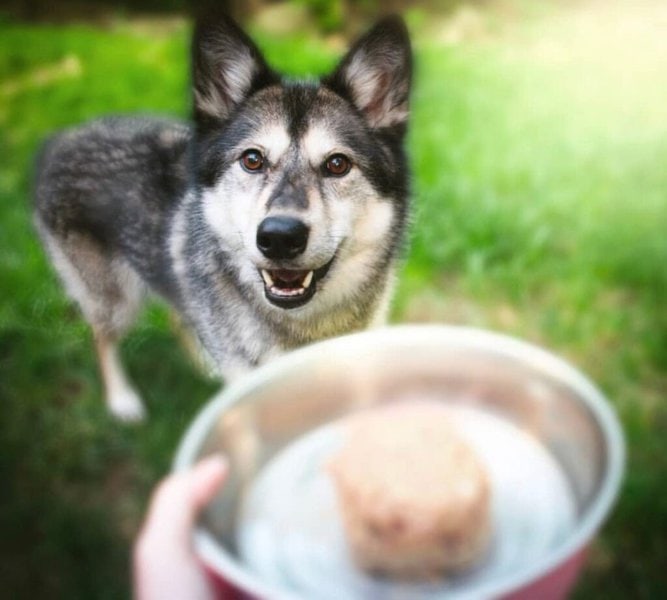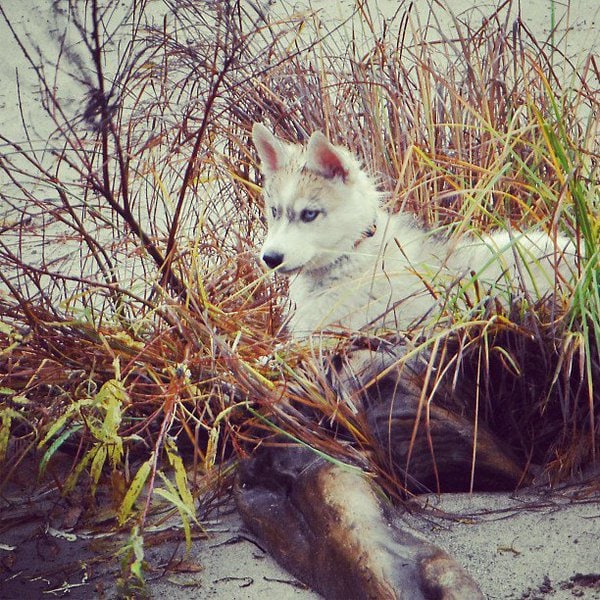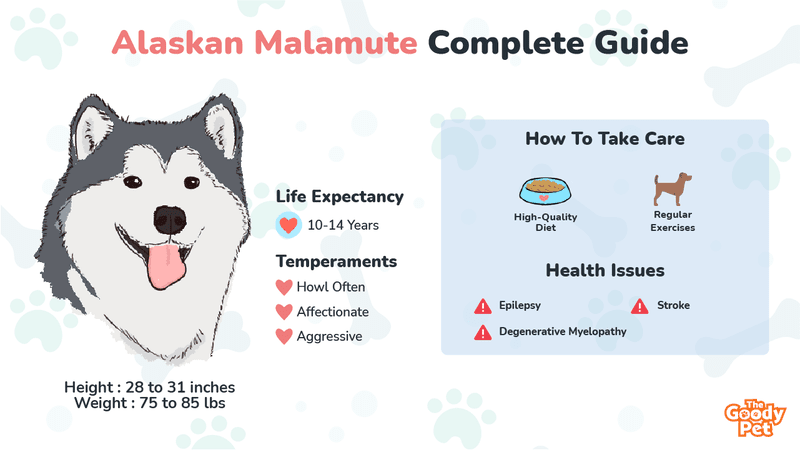Whether you’re interested in owning the popular Alaskan Malamute, or if you’re already a proud owner and want to learn more about this fascinating breed, this post is here to help! So what exactly is an Alaskan Malamute?
The Alaskan Malamute is one of the most striking dogs in the world of sled dogs. This mighty canine has a physique similar to that of a wolf! It is also simply known as “Mally.”
This article will help you gain a strong understanding of this extraordinary dog breed, and what you will need to know about owning and raising a Mally of your own.
How Big Do Alaskan Malamutes Get?
Alaskan Malamutes can grow between 28 to 31 inches tall, and weigh between 75 to 85 lbs. These pooches typically reach their peak of growth between the age of 1 and 2.
As an Arctic dog breed, these pooches are bred to perform strenuous tasks, such as pulling snow sleds, hauling loads, and retrieving objects over mountainous terrains. That is why they tend to eat a lot for the work they do.
Therefore, the weight of Alaskan Malamute can fluctuate and depends on how much food they’re eating, as well as what kind of food it is. This will ultimately affect its size.
Physical Appearance
It has been said that the typical eye color of an Alaskan Malamute is either brown or dark gold. The eyes will be of medium size and usually almond-shaped.
These dogs have triangularly shaped ears with rounded tips, sitting on a broad skull with a rounded top between the ears – great for petting, and Mallies sure do love their head pats. They all come with a fairly large muzzle.
As for their noses, their colors vary based on their coat colors and patterns, including:

Silver
Alaskan Malamutes can come in silver-gray color coats with black masks, ears, and feet. White markings can be found on their chests and faces. They will also have a black nose.
Fawn
Fawn-colored Alaskan Malamutes can usually be found on purebred female Mallies, whom the reputable breeders have bred for several generations. Most purebred Mallies won’t start with fawn coats until around two years old. They will also have either a brown or pink nose.
Red
This is a rare but naturally occurring coat color in Alaskan Malamutes, often found in some strains of red-nosed dogs, such as the Irish Water Spaniel or the Australian Cattle Dog. Red-nosed Mally puppies can be born with this color from time to time, but it isn’t as common as silver or fawn Mally pups.
How Long Do Alaskan Malamutes Live?
Alaskan Malamutes can live as long as between 10 to 14 years, of course, with the proper care and the right nourishment.
Mallies are generally healthy, but they can suffer from hereditary disorders. Here are some of the common health problems these dogs face:
Stroke
A blood clot in the brain can cause a stroke in an adult Alaskan Malamute, thereby leading to death in severe cases. Symptoms will include changes in behavior, muscle weakness, paralysis, and other neurological problems. Screen your dog for this fatal condition by having them examined by a veterinarian.

Epilepsy
This disorder causes seizures or fits of abnormal activity that cause the muscles to convulse, dance around or jerk uncontrollably. A seizure can last for just a few seconds or several minutes, but it is usually sudden and lasts no longer than five minutes. Seizure activity begins with one or more brief muscle contractions before ending with restlessness.
Degenerative Myelopathy
This condition affects the spinal cord or nerves that run along the spinal cord. It can be caused by trauma or injury to the bone, cartilage, or nerves above the spinal cord.
Once damaged, these nerves become more susceptible to damage from further physical trauma. The damage to the nerve cells can cause pain to become acute, and no treatment can completely reverse these effects.
How To Take Care Of Your Alaskan Malamute?
Taking care of your Alaskan Malamute should include, but is not limited to, the following aspects such as setting up an exercise routine, providing a high-quality diet, and maintaining oral health, for a happy and healthy dog.
Exercise Routine
Setting up an exercise routine for the Alaskan Malamute is crucial to keep such an active dog breed fit and healthy. You can consider taking your Alaskan Malamute on a long walk or run every day. If possible, do the same route every time such that your pooch will feel more at ease once it has become accustomed to this routine.
Alaskan Malamutes require at least 45 to 60 minutes of exercise every day. You can split the duration into two sessions at different times of the day, morning and evening. Exercising with your pooch can also be an opportunity for bonding.
High-Quality Diet
Proper nutrition is a must for your Alaskan Malamute to maintain a healthy weight and look. It requires plenty of proteins and a variety of foods to grow and thrive, which means you need to make sure you’re feeding them the best.
An Alaskan Malamute should ideally be fed 3 to 4 cups of high-quality dog food and kibble every day. This can be split into three meals per day. Avoid overfeeding your pooch as the issue of obesity can pose several health concerns for such a large dog.
For this, we recommend the Pet Plate Barkin’ Recipe. Each meal is freshly prepared with the finest human-grade ingredients for your pooch to enjoy its richness and packaged using natural storage techniques to be delivered to your doorstep.
In addition, omega-3 and vitamin A are essential in boosting the immune system and maintaining both the coat and skin health of your Mally.
Multivitamins
Multivitamin supplementation is vital to make up for mineral deficiencies that the regular dog diet cannot provide for your Alaskan Malamute. Some of these important multivitamins will include:
Omega-3 fatty acids are essential to help maintain healthy skin and to reduce inflammation in the body, which is suitable for your Mally with dry skin and irritated joints or problems with arthritis.
Dogs normally are unable to manufacture their probiotics, which is necessary if their digestive system has been damaged due to diseases or stress. Probiotics can help protect your Mally against pathogens, such as harmful bacteria and yeast infections in its body.
Manganese-rich foods are excellent sources of calcium for your Mally because this mineral helps to maintain strong bones throughout its life and prevent bone disorders like osteoporosis. The regular consumption of manganese-rich foods may help with keeping blood pressure at an ideal level in your dog.
Dental Care
The use of dental water additives helps keep the teeth and gums of your Alaskan Malamute clean and healthy. It also reduces the risk of periodontal diseases and tooth decay by neutralizing the acid produced by plaque. Add such additives to the drinking water you feed your Mally every day, and you are all set!
Are Alaskan Malamutes Aggressive? Temperaments Of Alaskan Malamutes
Alaskan Malamutes are instinctively aggressive if they have not been domesticated well nor undergone proper socialization training. They can display some level of aggression, especially to small animals and even children.
Be sure to get your Alaskan Malamute to be properly trained by a professional and introduce children to the pooch, preferably during puppyhood, as part of the socialization training.
Is Alaskan Malamute A Good Family Dog?
When untrained, mature Alaskan Malamutes are generally not suitable for owners with small children or other pets because of their aggressive tendencies. They can be good family dogs if and only if they are well socialized and continue training throughout their lives.
As mentioned, introducing your children to your Mally as a puppy is important in becoming a family dog. When properly trained, Alaskan Malamutes are affectionate dogs and thrive well on human companionship.

Can Alaskan Malamutes Be Left Alone?
Alaskan Malamutes cannot be left alone for more than 12 hours. Without social interactions, they tend to be less mentally stimulated and can bark to seek the owners’ attention, sometimes so loud that they can become a noise nuisance.
Hence, if you need to be away from your Mally for hours, consider hiring a professional sitter or putting it up in a dog daycare center in your absence.
Do Alaskan Malamutes Bark A Lot?
Alaskan Malamutes do not bark a lot. When they do bark, however, it is often for a reason to alert their owners about something, especially when they see strangers coming up to your yard or when small animals are found scurrying across your garden.
Instead of barking, Mallies do howl quite often, typically when they are feeling lonely or trying to communicate with one of their own when they have heard similar howling in the distance at night.
Are Alaskan Malamutes Good Indoor Dogs?
Alaskan Malamutes do not make great indoor dogs because they are working dog breeds. Spending time outdoors is what will suit them better.
They are also notoriously known to have a knack for digging. This stems from their survival instincts in digging a hole to seek shelter underground during winter. As such, consider designating a digging spot for your Mally and fencing up the area around the spot to prevent it from escaping through the dug-up hole.
How Often Should You Bathe A Malamute? Grooming Tips For Alaskan Malamutes
As a general rule of thumb, you should bathe your Alaskan Malamute once every 4 to 6 weeks.
Bathing your Mally too frequently will result in the loss of essential oils to protect the skin from dryness and itch. That being said, it is always good to bathe whenever it is back from an outdoor trip to remove any foreign dirt and to avoid accidentally licking that can lead to stomach upsets, but do keep the bath time short for this case.
If your Mally has a sensitive skin condition, we recommend using a gentle shampoo like Pro Pet Works All Natural 5 In 1 Oatmeal Shampoo. This product comes with a soap-free formulation, great for dogs with sensitive skin types, and contains both oatmeal and Aloe vera ingredients to help soothe the skin.
Shedding
Due to its double coat, Alaskan Malamutes shed all year round and especially heavily during the shedding season, fall and winter. Hence, they are not considered to be hypoallergenic dog breeds.
Do exercise caution when there are people with sensitivity to dander at home where your Alaskan Malamute roams. You will not want to trigger an allergic reaction and cause much discomfort to these people.
Regular Brushing
To bring down its shedding level to a more manageable level, we recommend that you perform daily brushing on your Mally, preferably once every day. Regular brushing not only reduces dander from landing all over your room or the house but also fosters better bonding with your pooch.
For this, try out the FURminator Undercoat Tool. It is a great tool with an ergonomic handle that facilitates smoother brushing, thereby shortening each brushing session for your pooch’s relief. It also comes with a quick-release button to help with the cleanup much easier.
Grooming
Consider sending your Alaskan Malamute for professional grooming or a haircut once every 6 to 8 weeks. Given their double coat, when no grooming is done on your Mally, its coat can grow long fairly quickly, resulting in matting and knotting of hair.
Mats are a source of irritants to your pooch and can breed bacteria under moist conditions, resulting in greater discomfort and unbearable itch. Should this happen, you may have to resort to cutting segments of your Mally’s coat or giving your pooch a shave.
Cleaning Their Ear
Always remember to clean their ears too. This is an integral part of grooming since dogs will usually require external assistance to keep their ears clean. Uncleaned ears, together with long hairs, can cause rapid bacterial growth, leading to an ear infection.
Trimming Their Nails
It is important to trim their nails regularly or whenever they are long. Overgrown nails not only cause physical discomfort to your Alaskan Malamute during movements, but it also damages the flooring of your house.
Related Questions
How Much Does An Alaskan Malamute Cost? You should be expecting to pay between $1,500 and $3,500 for an Alaskan Malamute puppy. The cost of an Alaskan Malamute dog varies depending on your location, the breed’s health status, and the coat color.
Can Alaskan Malamutes Survive In Hot Weather? No, Alaskan Malamutes will not be able to survive in hot weather conditions, especially when they have not acclimatized to warmer climates. Alaskan Malamutes are dogs who thrive very well in cold, snowy environments and are ideal companion dogs for people living in the Arctic regions.
Do Alaskan Malamutes Like To Swim? Alaskan Malamutes do like to swim and are capable of swimming. However, some Mallies may not be natural swimmers and will require training to stay afloat in water bodies. Swimming is a great activity for Mallies during summer or warm weather, as water provides a cooling effect for these double-coated dogs.





